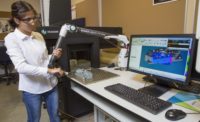3D measurement arms, also referred to as articulating arms, are portable coordinate measuring machines (CMMs) that pinpoint and record the location of a probe and record the results through software.
These arms use encoders, or special glass parts, to measure a probe’s location. They range from 2 to 6 feet, but some can reach double that. However, shorter arms tend to be more accurate and precise. These arms can encompass a wide range of motion, and typically come with 6 axes of rotation.
Articulating arms are portable and are typically smaller and lighter than traditional CMMs. This makes inspection easier, since operators can move them to measure a part as opposed to moving the part to the CMM. This reduces downtime and promotes efficiency.
Arms are also highly adaptable. They can usually acclimate to most temperature conditions, which means they can work in a wide range of environments —not just a temperature-controlled inspection room. 3D measurement arms are typically much more effective than inspection hand tools.
The evolution of 3D measurement arms
Historically, handheld measurement tools have been the standard in capturing part dimensions. However, these mechanically simple tools are limited to measuring basic dimensions such as widths, lengths, and thicknesses. Such hand tools also warrant skilled operators. Coordinate measuring machines then came along, making it easier to capture measurements with higher accuracy than hand tools. These CMMs were fixed, meaning that their probes can only move in three axes and only travel within the extent of the CMMs measurement bed. Eventually, articulating arm CMMs were invented. They provide the same functionality as a fixed CMM but are also portable and flexible. While they may be less accurate than fixed CMMs, they usually weigh less than 20 pounds, are easy to operate, and are highly affordable.
Articulated arms can be used for the following:
- Dimensional analysis, or gathering part information to compare data to drawings and blueprints • CAD-based inspection: Comparing parts to 3D CAD models in real time for instant feedback
- On-machine inspection: Using the movability of an arm to inspect a part before, during and after its production, all while it’s mounted on a machine tool
- First article inspection: Evaluating pre-production samples and contrasting them with nominal data
- Alignment: Correcting the orientation of tools and fixtures
- Reverse engineering: Recording a part’s distinctive details with the arm or laser line scanner
Articulating arms have the adeptness, dependability, and precision of a traditional CMM while also being portability and simple to use. These arms can easily inspect parts that were once considered complex with a laser line scanner. They are ultimately associated with reduced scrap, quicker inspections, fewer defects, and a boost in product quality.





